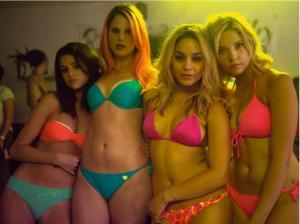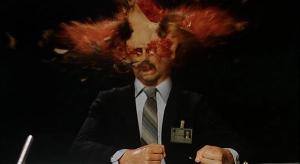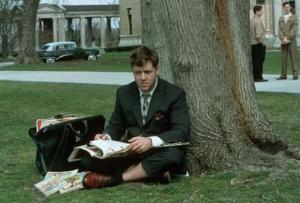G.I. Joe: Retaliation
Rating: 2/5
Any film is instantly improved at least twofold with the inclusion of Dwayne Johnson. The most electrifying man in all entertainment, Johnson has become a massive box office draw in recent years, and has already revitalised the Fast and Furious franchise, so much so that the fifth instalment was easily one of the best films of 2011, and great things are expected of the sixth. His casting in the latest G.I Joe film was, therefore, a smart business decision, and the only reason why I was excited to see it.
Retaliation expects its viewers to be aware of the first movie, Rise of the Cobra, but it’s not difficult to catch up. The characters are no more complex than their plastic toy origins – simple, quickly established, handily divided between good guys and bad guys. The Duke (Channing Tatum), the first film’s star, and his best buddy, the aptly named Roadblock (a supremely beefed up Johnson), have some nice exchanges early on, hinting at the comedy potential of this pairing, but Tatum is quickly dispatched, letting Roadblock take the helm. Tasked with stopping a fiendish plot of truly global proportions, he and his remaining companions (a pretty girl and a handsome man, both devoid of personality) are forced to fight the good fight without the usual government support; cue lots of dialogue-as-exposition, explosions and, in one head-spinning, eye-ball straining (particularly in 3D) set piece, an acrobatic sword fight on a Himalayan cliff-face.
G.I. Joe: Retaliation does exactly what it says on the tin – it has no aspirations to greatness, just to mindless entertainment. Yet even Johnson cannot save it from mediocrity. Some decisions work well – the inclusion of Jonathan Pryce as both a villain and an ally adds some respectability – and some, less so. Bruce Willis, who features heavily in the trailers, cameos as an older version of a young Bruce Willis, and is utterly irrelevant. The big bad, masked villain Cobra, does destroy London in a all-too-brief scene that Roland Emmerich would be proud of, but the overall film is underwhelming, oddly convoluted, and – most disappointingly – not silly enough to be entertaining.
Dark Skies
Rating: 3/5
Opening with an Arthur C. Clarke quote, Dark Skies is a standard genre flick in which an average family – recently laid off husband, nice wife, two young sons – are terrorised by aliens. With the household dynamics quickly established, the extraterrestrial activity begins; first dismissed as a wild animal’s quest for food, then a prank, it soon becomes clear that something otherworldly is going on.
Primarily a visual effects man, writer/director Scott Stewart keeps the effects to a minimum, preferring to retain an air of mystery, to the film’s benefit. The aliens, typical greys, are glimpsed only in shadows, or out of focus creeping behind an unwitting character and, even then, are rarely on screen. As the family start experiencing stranger and stranger phenomena, including sleepwalking, losing time, and hallucinating, again the effects are minimal and, consequently, there are some well placed jumps and some unsettling, eerie moments.
As parents Lacy and Daniel, Keri Russell and Josh Hamilton are likeable though both slightly drippy; too much focus is paid to their sons, neither of whom are particularly convincing. JK Simmons (Juno, Burn After Reading) appears for a few brief scenes as UFOlogist/ conspiracy theorist Edwin, but he is woefully underused. As the film progresses, any character development becomes overwhelmed by the narrative – the family’s money problems are quickly forgotten, for example – and, despite a promising, if formulaic, start, it falters in the final scenes, with a silly, tacked on twist designed to offer a glimmer of hope in what would otherwise be a rather bleak conclusion. Effective but uninspiring, Dark Skies is a good example of a conventional genre film, but never becomes anything more.
The Odd Life of Timothy Green
Rating: 3/5
The latest live-action Disney movie, The Odd Life of Timothy Green is an example of a rare genre in today’s gritty world, where darker is automatically better – a wholesome, old-fashioned family movie. Its plot is a simple reinterpretation of the mandrake root baby (as seen in both Harry Potter and Pan’s Labyrinth): a young couple who can’t have children spend a night writing down all the qualities their imaginary son or daughter would have, put the notes in a box and bury it in the garden, only to discover a muddy child with leaves growing out of his ankles in their kitchen a few hours later.
The overall feeling throughout Timothy Green is one of general niceness, but there are some strange lapses in judgement that threaten its amiable nature. Timothy himself, who emerges as a ten year old boy, develops a friendship with a sour-faced older girl, but this friendship is tinged with inappropriate romantic notions. Worse than this, however, is the contrast between Cindy and Jim Green, and all the other parents, who are alternately revealed as power-hungry, inconsiderate, weak, unsupportive and, in the worst cases, unloving liars. While it is clear the Greens are born to be parents, it seems a shame that no one else in the town is.
It’s hard to be too critical, however. This is a film with some dislikeable people, but no real enemies; a film in which family values are the most important thing, and one in which everyone learns and grows as a result of kindness and a simple miracle. Celebrating family life and small town culture, it is harmless and superficial but pleasant despite its missteps.
All Things to All Men
Rating: 2/5
The latest gritty Brit gangster movie, All Things to All Men sees a corrupt cop, his slightly less corrupt partner, and an idealistic newbie on the hunt for a London crime boss, whose son is a cocaine-dealing junkie. There’s also a diamond thief who plays some kind of role, but by the end, you just won’t care.
Even the addition of Gabriel Byrne as aforementioned crime boss/ godfather Joseph Corso isn’t enough to save this tedious film; he is personable but underwhelming. The acting is all perfunctory – the British cast do what they can to make their two-dimensional characters memorable, but the script is sloppy and poorly judged, and despite their physical differences, the almost exclusively male cast blur into one blank-faced non-entity. No one is particularly likeable – Leo Gregory’s rookie cop Dixon is supposed to be the most affable, one assumes, because of his noble sob story motivations, but it is too clichéd to be effective.
Despite the mystery and intrigue, and even despite the clunky inclusion of a car chase, this is a dull, unoriginal affair. London is used well – a wealth of famous landmarks, from the Eye to Battersea, are the backdrops to conversations and illicit drops, all shot in gritty, muted shades of grey. The film’s score is incessant and irritating, forcing tension and emotion out of an unemotional, lacklustre script. Some pizzazz has been added in the form of a string of expensive cars, but even the two-second inclusion of an Aston Martin is not enough to get the heart racing. All Things to All Men is boring, conventional, entirely lacking humour or personality, overly convoluted and, right until the very end, dull.
Spring Breakers
Rating: 3/5
Hailed as writer/director Harmony Korine’s most mainstream film, Spring Breakers is part Girls Gone Wild, part MTV music video, part neon trash, part coming-of-age heist movie, but never really manages to be entertaining. It is a divisive movie, but more than that, it is an utterly hollow movie.
The big coup, the film’s greatest success, is its casting of former clean-cut Disney stars (Vanessa Hudgens, Selena Gomez, Ashley Benson) as interchangeable blondes whose only aspirations are to have an unforgettable spring break. After failing to save enough money, even with the help of their nice Christian friend Faith (yes, really), they opt to rob a diner; thus begins their summer of crime. In Florida, surrounded by other spring breakers, they enjoy drugs and the promise of sexual liberation, before joining with pathetic white gangsta Alien (James Franco) who seduces them with guns and claims of the American dream.
Despite the onslaught of bare breasts, thongs, drug-taking and profuse swearing, Korine’s film never feels truly debauched. It is forced and superficial, like an awkward kid pretending to be wild to fit in. The characters are even flimsier than their tiny neon bikinis; Gomez’ Faith comes closest to actually developing, but as soon as she considers it, she heads back home, leaving the three identikit teens to continue the mayhem. They do so in scenes that repeat themselves over and over, displaying the party lifestyle while voice-overs discuss pseudo-profound inanities like destiny and finding oneself on a loop. Yet if this is supposed to be ironic, it never quite manages to make itself clear. Instead it feels disjointed and monotonous; the girls go from drawing giant cocks on their school books to robbing students at gunpoint in what seems like a few days, with no sense of transition or reason.
Perhaps Korine’s film is supposed to be vacuous; a reproduction of the superficiality of teens who really do believe that partying for a week is a life-changing experience. And perhaps it’s okay that no one really learns any kind of lesson. Yet for a film so clearly rooted in trash, it never really becomes trash. It never really achieves the porno style it is emulating; the parties never seem vibrant, the music – by Cliff Martinez, whose techno score was so effective in the superb Drive – never quite reaches the deliriousness that should be felt. By the end, all the chaos and partying becomes nothing; Spring Breakers is completely empty.







